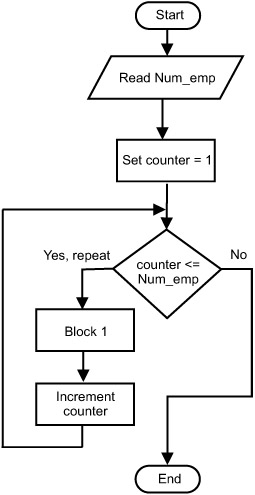8.3 The Salary Problem with Repetition
8.3 The Salary Problem with Repetition
This version of the salary problem includes repetition so that the same calculations for salary increase are applied to a given number of employees of a company. Assume that the sequence of instructions for calculating the salary increase is the same as the salary problem already discussed. These operations are grouped in Block1 and are to be repeated for every employee.
In designing the algorithm for this problem, the sequence of instructions in Block1 is placed in a loop. The while statement contains the condition that compares the loop counter with the given number of employees.
To simplify the problem, assume that the algorithm first reads a variable from the input list. This variable is an integer that represents the number of employees to compute the salary increase and update their salaries. The name of this variable is Num_emp. The value of this variable determines for how many employees to calculate the salary increase, and updates the salary. Figure 8.2 shows the portion of the flowchart for the algorithm for the salary problem with repetition.

Figure 8.2: Salary problem with repetition.
Variable Num_emp denotes how many times to repeat the block of instructions in Block1. For example, if the value of Num_emp is 10, this means that there are 10 employees, and the block of instructions will be repeated 10 times, once for each employee.
The condition for the repetition (loop) is: counter less or equal to Num_emp. The last instruction in the loop increments the value of variable counter.
The flowchart in Figure 8.2 shows only the repeat structure of the algorithm and Block1 contain all the instructions that are repeated. This is a simple way to modularize a program, in other words, group instructions into small modules. This also helps reduce the size of the flowchart.
The corresponding code in KJP for the algorithm is:
integer Num_emp // number of employees to process integer counter . . . read Num_emp // read number of employees set counter = 1 while counter <= Num_emp do // instructions in Block1 increment counter endwhile . . .
A complete implementation of the algorithm for the salary problem is implemented in classes Employee_m and Salarym. The operations for calculating the salary increase and updating the salary for every employee are implemented in class Employee_m, which is the same as discussed previously.
| On the CD | The code for the KJP implementation of class Salarym follows; it is stored in the file |
description This program computes the salary increase for a number of employees. If the employee's salary is greater than $45,000, the salary increase is 4.5%; otherwise, the salary increase is 5%. The program also calculates the number of employees with a salary greater than $45,000 and the total amount of salary increase. */ class Salarym is public // description This function creates objects to compute the salary increase and update the salary. This calculates the number of employees with salary greater than $45,000 and the total salary increase. */ function main is variables integer num_emp // number of employees integer loop_counter real salary string name integer age real increase real total_increase = 0.0 integer num_high_sal = 0 // number employees // with salary greater than 45000 objects object emp_obj of class Employee_m begin // body of function display "enter number employees to process: " read num_emp set loop_counter = 1 // initial value while loop_counter <= num_emp do display "enter employee name: " read name display "enter salary: " read salary display "enter age: " read age create emp_obj of class Employee_m using name, salary, age if salary > 45000 then increment num_high_sal endif call sal_increase of emp_obj set increase = call get_increase of emp_obj // updated salary set salary = call get_salary of emp_obj display "Employee: ", name, " increase: ", increase, " salary: ", salary increment loop_counter add increase to total_increase // accumulate endwhile print "Number employees with salary > 45000: ", num_high_sal print "Total amount of salary increase: ", total_increase endfun main endclass Salarym
| On the CD | The code for Java implementation of class Salarym follows and is stored in the file |
// KJP v 1.1 File: Salarym.java, Fri Dec 06 11:28:28 2002 /** This program computes the salary increase for a number of employees. If the employee's salary is greater than $45,000, the salary increase is 4.5%; otherwise, the salary increase is 5%. The program also calculates the number of employees with a salary greater than $45,000 and the total amount of salary increase. */ public class Salarym { /** This function creates objects to compute the salary increase and update the salary. This calculates the number of employees with salary greater than $45,000 and the total salary increase. */ public static void main(String[] args) { int num_emp; // number of employees to process int loop_counter; float salary; String name; int age; float increase; float total_increase = 0.0F; // accumulator int num_high_sal = 0; // number employees with // salary greater than 45000 Employee_m emp_obj; // body of function starts here System.out.println( "enter number of employees to process: "); num_emp = Conio.input_Int(); loop_counter = 1; // initial value while ( loop_counter <= num_emp ) { System.out.println("enter employee name: "); name = Conio.input_String(); System.out.println("enter salary: "); salary = Conio.input_Float(); System.out.println("enter age: "); age = Conio.input_Int(); emp_obj = new Employee_m(name, salary, age); if ( salary > 45000) { num_high_sal++; } // endif emp_obj.sal_increase(); increase = emp_obj.get_increase(); // get updated salary salary = emp_obj.get_salary(); System.out.println("Employee: "+ name+ " increase: "+increase+" salary: "+ salary); loop_counter++; total_increase += increase; // accumulate } // endwhile System.out.println( "Number of employees with salary > 45000: "+ num_high_sal); System.out.println( "Total amount of salary increase: "+ total_increase); } // end main } // end Salarym EAN: 2147483647
Pages: 184